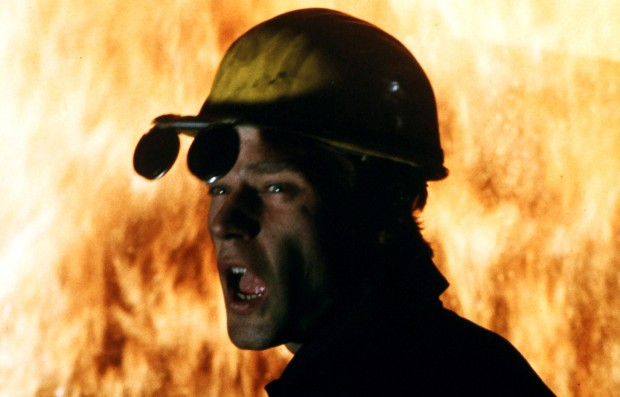
Speaking before the audience at last night’s screening of Michael Glawogger’s Workingman’s Death — which had been added just a few days ago to The Film Society of Lincoln Center’s Art of the Real Festival, following the news of the filmmaker’s death last week — programmer Dennis Lim called the “traveling filmmaker” a “guiding light of the festival.” Glawogger, I described in my review of Whores’ Glory, is a filmmaker that “goes places even Mike Rowe of Dirty Jobs could never go — not on basic cable, anyway.”
I had been introduced to the filmmaker and his films through Lim five years ago at the Flaherty Film Seminar. Named for Francis Flaherty, the wife of Robert (widely considered the father of documentary cinema, although he, like Glawogger, often employed recreations and fictions), is a kind of cinematic summer camp. Approximately 125 film scholars, filmmakers and graduate students attend a weeklong seminar from which there is no escape, only surrender. In theory, it sounds it like a film festival — there’s three screenings a day, followed by a Q&A and either a meal or a drink, but the Flaherty is a truly immersive experience where conversations extend beyond simple question and answer sessions. Limiting the experience to 125, one often ends up having lunch or dinner with someone whose book you read, a filmmaker whose work you’ve just seen and, in one instance, a women who signed a rejection letter from an MFA program that I had applied to.
Lim cautioned us on the first night not to consider the program’s title “Work” as a thesis title, despite the fact many films in the series were about the act of doing work; many simply rejected this narrow mold. Glawogger’s work on display included several shorts (notably Haiku, which had screened last night) and his features Megacities and Workingman’s Death. At this point Whore’s Glory had been in post-production and when asked about his portraits in Workingman’s Death, he cited a subject in Whore’s Glory who was one of the happiest people he had ever met. The funny thing about Workingman’s Death — a documentary about the extremes one will go to earn a wage — is they all have ambitions, a mandate, and are doing work that despite being dangerous and in one chapter gruesome, they generally lead happy lives outside of work, and thus feel fulfilled. Closing that film, children play in Germany on the grounds of a plant that ran non-stop, 365 days a year, 24 hours a day, which is now a park. Glawogger’s films were not without joy, mixing the hypnotic and the horrifying into a thesis on labor and globalization.

Screening Workingman’s Death and Haiku last evening was a fitting tribute to a filmmaker who died on April 22nd of malaria in Monrovia, Liberia while working on his next film. Haiku (pictured right), which had not screened in the United States until it showed at the Flaherty, can be viewed as a companion piece to Workingman’s Death. The experimental film, partially set on an industrial reactor, juxtaposes sounds of heavy industry with domestic scenes. It peeps into the home life of a worker and his wife; as the gears of the industry turn, she continues to ask him for “money for shopping.” Per Lim, after admiring the film at Flaherty, Glawogger gifted film scholar Scott MacDonald the print, which he loaned to the Film Society for last night’s show.
I have an intense admiration for Glawogger’s work. His films provide no easy answers and walk a fine line between several of Bill Nichols’ modes of documentary filmmaking. Bleak, but poetic, his work aestheticizes conditions like a Bangladeshi brothel district called The City of Joy. Encounters are often restaged, something I had asked the filmmaker about at Flaherty. Blurring the lines between narrative and verite, he employs real people to perform the kinds of jobs they’d perform in every day life. The technique is rarely distracting, but I cite a specific cut within the Mexico chapter of Whore’s Glory as the only time I ever questioned Glawogger’s approach.
At Flaherty, I had a brief conversation in passing with the filmmaker. Shaking his hand, I told him I was very glad to have discovered his work and asked him specifically about his portrait of New York City in Megacities. Growing up in Northern New Jersey, I had thought it was an accurate portrait of the pre-Disneyification of Times Square and it accurately reflected my impression of the Dinkins administration.
Glawogger corrected me, stating he shot the film in the early days of Rudy Giuliani’s administration, right before the city and Time Square had been cleaned up. He then offered up a strange pre-production encounter, coming across a drug addict on a 42nd Street corner weeping for what was to come, the destruction of “his” New York. While certain sections of New York have become friendlier and cleaner, it, like the other areas where Glawogger’s camera ventured, contains the ironies of extreme urbanization and globalization.
His films are essential and stunning, and it’s a filmmaker whom, if it was not for Lim and the Flaherty Seminar, I might have not discovered. I sincerely hope last night’s screening of Workingman’s Death will be the first in many retrospectives of his work (Lim had organized a four-city US tour of his work in 2012, in conjunction with the theatrical release of Whore’s Glory). From the the proud Pashtun men who recycle ten-story cruise ships in Pakistan (in Workingman’s Death) to small homes of prostitutes working in an infamous Mexican district called The Zone in Whore’s Glory, his behind-the-scenes documenting of brutal work, yet not without a tinge of joy, will be greatly missed.
Workingman’s Death is available on Amazon, Whore’s Glory is available on Netflix, and MegaCities is available on iTunes.

